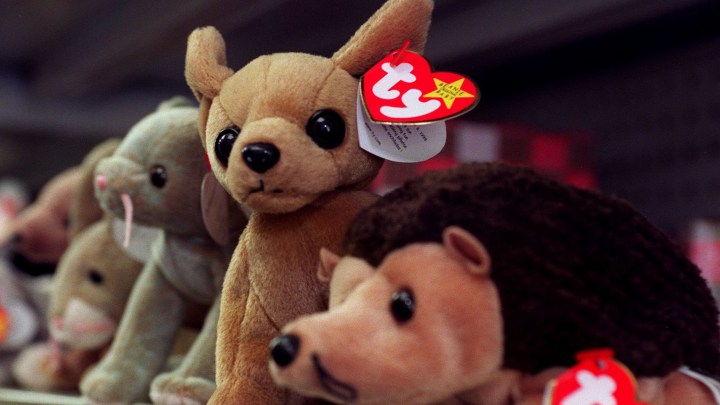
This month Econ Extra Credit is taking a look at speculative investment bubbles with some help from Beanie Babies. We’re watching the film “Beanie Mania” from 2021. Subscribe here to get the whole series in your inbox.
When a colleague suggested the 2021 documentary “Beanie Mania” as this month’s Econ Extra Credit selection, I knew it would be a film full of Marketplace themes.
Along with Pokémon cards, Beanie Babies were the first tool I ever used to teach a personal finance lesson to my own three kids back in the ’90s. That lesson was about how most things sold as “investments” and touted as “worth a lot some day” typically have no intrinsic value. While an object meaningful to you can be cherished by you, to the wider world it is only worth what someone else is willing to pay. And so it turned out to be with cardboard images of Squirtle, Eevee and Bulbasaur, or plush toys called Pinchers or Valentino. The kids would look amazed and amused when I would compare Beanies to the Pet Rock marketing campaign of my own youth.
Long ago, my father gave me a reprint of the 1841 edition of “Memoirs of Extraordinary Popular Delusions and the Madness of Crowds” by Scottish writer Charles Mackay. The volume sits as a grim talisman high on my bookshelf, a warning about not getting sucked into financial bubbles. When people went wacky with Beanies, Mackay’s book was there to remind me of the case of tulip bulbs in 17th century Europe and other episodes of financial mania. People got it in their heads that bulbs of flowers were the thing to have and were willing to pay wild sums. It didn’t last, and some people ended up watering their bulbs with tears.
Some years ago, Anne Goldgar, a historian at University of Southern California, found no evidence that this tulip mania caused a widespread financial meltdown in the Netherlands (or even bankruptcies). However, Mackay’s description of people in the grip of the delusion that what goes up never comes down remains instructive. Better examples of asset bubbles litter financial history: the dot-com bust and the Irish real estate bubble, both of which occurred in the early 2000s.
It is true you can make money earlier in a bubble, but since you cannot know when things are going to pop, you can also lose everything quickly and possibly go into debt. It’s too bad that Ty Inc., the company that manufactured Beanie Babies, never released a plush critter called Crypto Asset. A bitcoin isn’t cuddly, but it sure got caught up in the madness of crowds.
This month’s film does make it clear the Beanie phenomenon wasn’t only about people trying to profit through buying, holding or selling fabric filled with plastic pellets. Some people find what economists call utility just holding the fuzzy toys. Others enjoy buying similar objects to form a personal collection. If one fancy wristwatch or vintage Alfa Romeo gives you pleasure, perhaps a few more multiply the joy. Even people who don’t see themselves as collectors often are. How much extra bookshelf space do you have? Many of us find it hard to cast off books even when we have read them.
When you collect too much, it is a disorder called hoarding. Having worked to clean out and dispose of the homes of both my parents and my wife’s parents in recent years, I have come to one conclusion that keeps any urge for further collecting safely in check. I am calling it “They Don’t Want Your Crap,” or TDWYC for short (pronounced TID-wick). By “they” I mean “my children.” If I have trouble casting off my set of diecast scale models of NASA’s fleet of space rockets, I ask myself if my kids will want these when I am no longer around. I don’t have to wait to ask them; I already know the answer is no. TDWYC.
Since I don’t want to burden my heirs with stuff they don’t want, I might as well inject the stuff now into the circular economy, by any means necessary — eBay, yard sale or charitable donation. Heirs have their own tastes, their own memories and their own collections of objects that have special meaning to them. TDWYC.
If some day they want to remember me, they don’t need my objects. They can instead hold on to the memory of their dad as the inventor of TDWYC.
“Beanie Mania” is available to stream on Max with a subscription. Later in the month, we’ll be talking about the new movie dramatizing this phenomenon, “The Beanie Bubble,” which is available to stream on Apple TV+ with a subscription.
After you watch, send us your thoughts and questions at extracredit@marketplace.org or reply to this email!
There’s a lot happening in the world. Through it all, Marketplace is here for you.
You rely on Marketplace to break down the world’s events and tell you how it affects you in a fact-based, approachable way. We rely on your financial support to keep making that possible.
Your donation today powers the independent journalism that you rely on. For just $5/month, you can help sustain Marketplace so we can keep reporting on the things that matter to you.


















